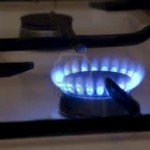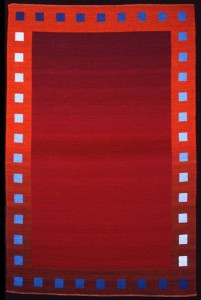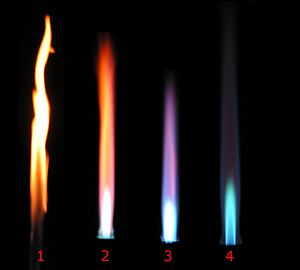 The dominant color in a flame changes with temperature. The photo of the fireplace fire is a good example of this variation. Near the logs, where most burning is occurring, the fire is white, the hottest color possible for organic material in general, or yellow. Above the yellow region, the color changes to orange, which is cooler, then red, which is cooler still. Above the red region, combustion no longer occurs, and the uncombusted carbon particles are visible as black smoke.
The dominant color in a flame changes with temperature. The photo of the fireplace fire is a good example of this variation. Near the logs, where most burning is occurring, the fire is white, the hottest color possible for organic material in general, or yellow. Above the yellow region, the color changes to orange, which is cooler, then red, which is cooler still. Above the red region, combustion no longer occurs, and the uncombusted carbon particles are visible as black smoke.- Red
- Just visible: 525 °C (980 °F)
- Dull: 700 °C (1,300 °F)
- Cherry, dull: 800 °C (1,500 °F)
- Cherry, full: 900 °C (1,700 °F)
- Cherry, clear: 1,000 °C (1,800 °F)
- Orange
- Deep: 1,100 °C (2,000 °F)
- Clear: 1,200 °C (2,200 °F)
- White
- Whitish: 1,300 °C (2,400 °F)
- Bright: 1,400 °C (2,600 °F)
- Dazzling: 1,500 °C (2,700 °F)
According to the info above (source: Wikipedia) the difference between red-hot and white-hot is about 1000 degrees. But what about blue-hot?
Anytime you see blue in a fire it is hotter than white. The range is between 2,600 and 3,000 degrees Fahrenheit and its the most oxygen-rich type of flame. A bunsen burner is a good example:
Bunsen burner flames:
1) air hole closed
2) air hole slightly open
3) air hole half open
4) air hole almost fully open (this is the roaring blue flame).
 Bunsen burners use a mixture of gases. Gas burns hotter than organic materials such as wood and straw. Natural gas stove flames are blue. Propane flames are blue with yellow tips. The hottest fires are from oxyacetylene torches (about 3000 degrees Centigrade) that combine oxygen and gas to create pinpoint blue flames.
Bunsen burners use a mixture of gases. Gas burns hotter than organic materials such as wood and straw. Natural gas stove flames are blue. Propane flames are blue with yellow tips. The hottest fires are from oxyacetylene torches (about 3000 degrees Centigrade) that combine oxygen and gas to create pinpoint blue flames.
 Color also tells us about the temperature of a candle flame. The inner core of the candle flame is light blue, with a temperature of around 1800 K (1500 °C). That is the hottest part of the flame. The color inside the flame becomes yellow, orange, and finally red. The further you get from the center of the flame, the lower the temperature will be. The brightest red portion is around 1070 K (800 °C).
Color also tells us about the temperature of a candle flame. The inner core of the candle flame is light blue, with a temperature of around 1800 K (1500 °C). That is the hottest part of the flame. The color inside the flame becomes yellow, orange, and finally red. The further you get from the center of the flame, the lower the temperature will be. The brightest red portion is around 1070 K (800 °C).
The round blue flame is a photo of a candle burning experiment in the International Space Station. Candle flames on earth have several different temperatures within the flame due to the variations caused by convection flows. In the zero gravity of the space station the flame burns rounder, slower, hotter and more blue.
Our traditional associations for color and temperature tell us that red is hot and blue is cold. How hard is it to think of blue as a hot color?
 Traditional color theory says that warm colors advance and cool colors recede. In my experience, this is only true when the colors are the same saturation. If you have a pure red and a pure blue – the red advances. If you have a brick red and a bright turquoise blue – the blue advances. Higher saturation trumps warmth every time.
Traditional color theory says that warm colors advance and cool colors recede. In my experience, this is only true when the colors are the same saturation. If you have a pure red and a pure blue – the red advances. If you have a brick red and a bright turquoise blue – the blue advances. Higher saturation trumps warmth every time.
Weaver Michael Rohde plays with color in his tapestries and rugs. When does the blue jump in front of the red in this rug?


August 12, 2021 at 1:24 am
i love blue fire 🙂
December 11, 2013 at 9:51 am
This web sight has helped me a lot with my science fair project because it is based off of the color of fire.and the temperature so thanks. btw I’m in 7th grade
September 3, 2013 at 1:18 pm
what color is the blue temperature???
September 29, 2011 at 4:21 pm
love rainbows!
August 27, 2011 at 1:24 am
Being a science geek, I have always thought of it as the hot color. I have to always remind myself when I use a faucet that red is hot. God knows why I do everytime.